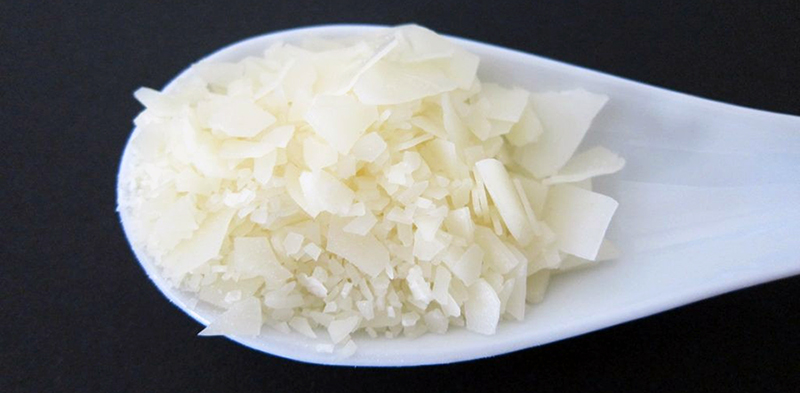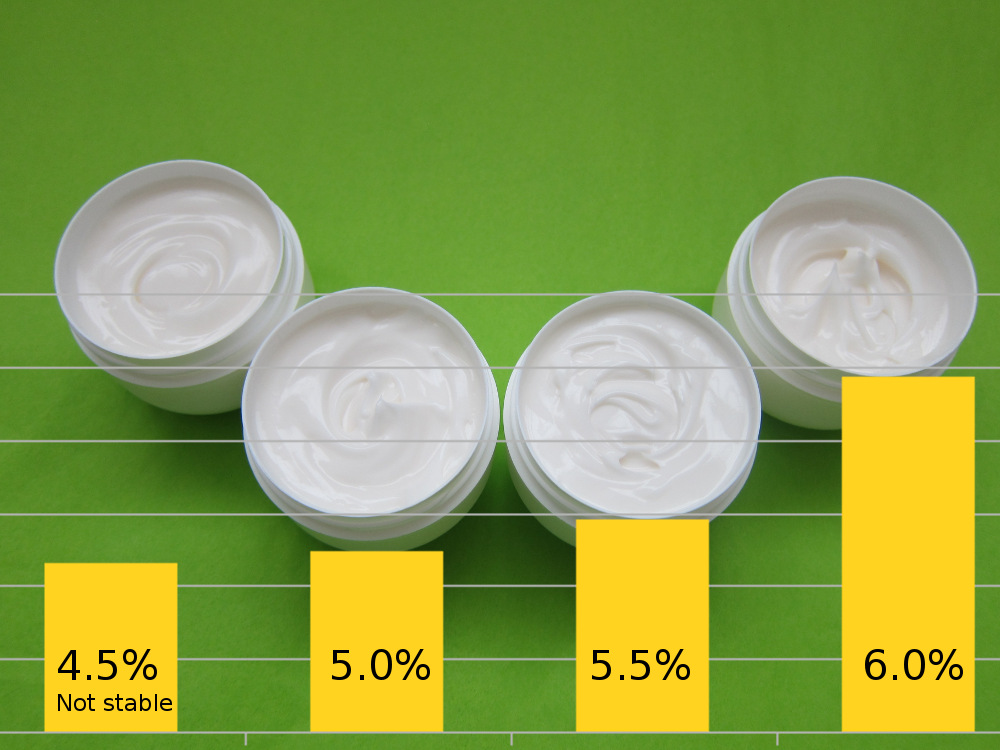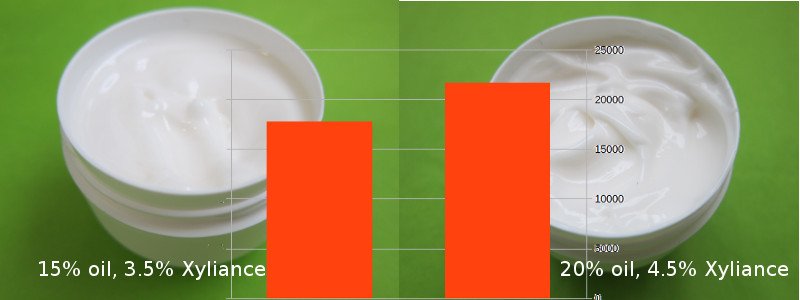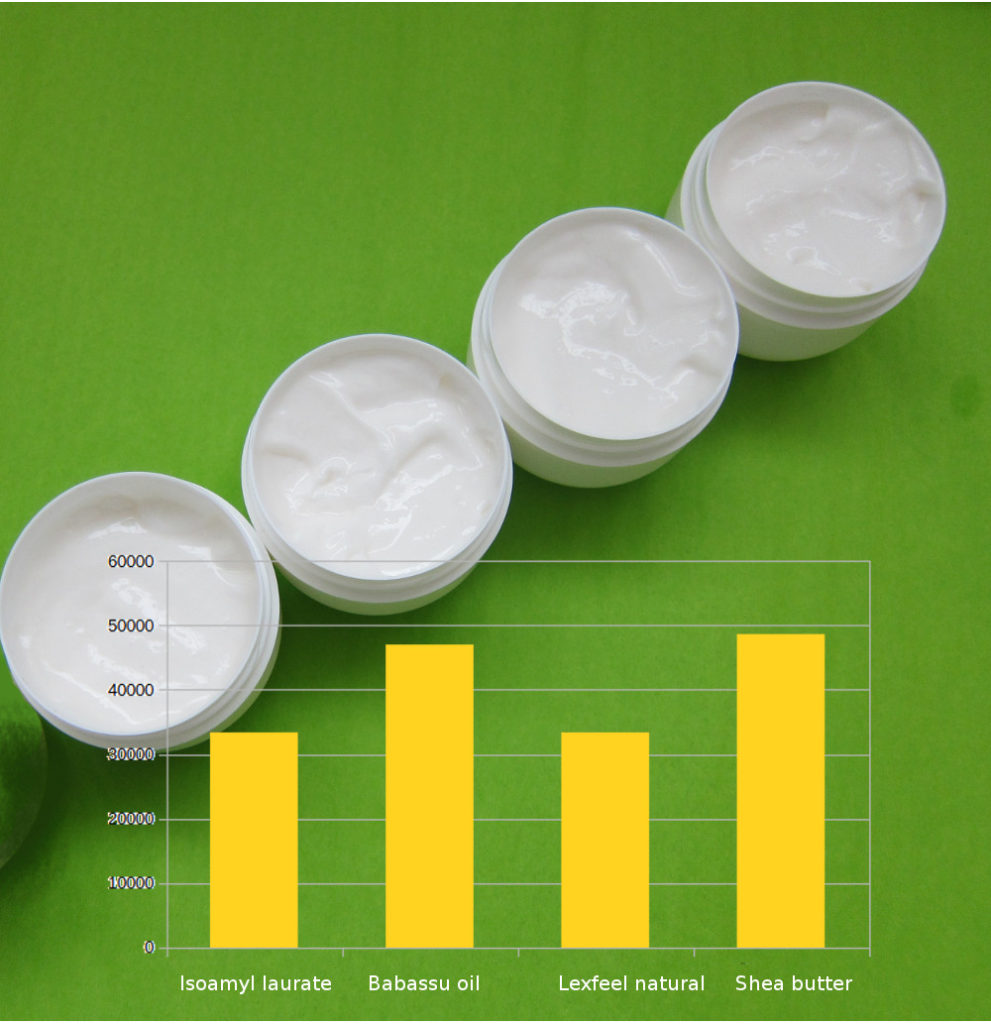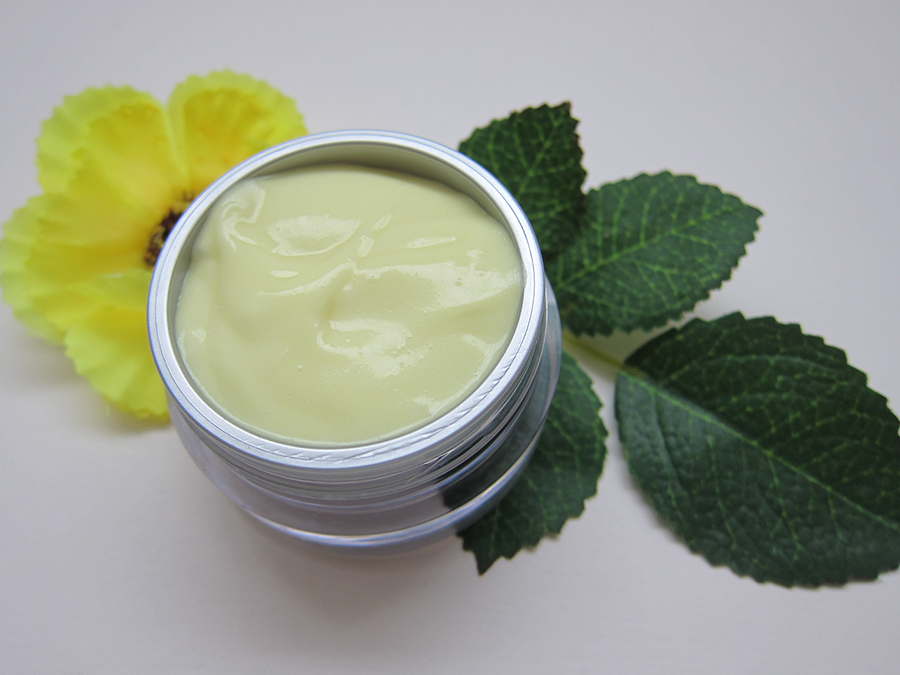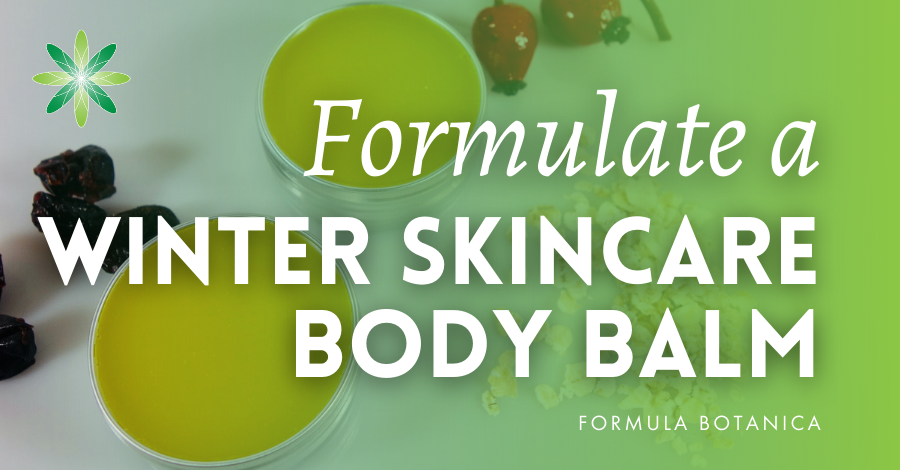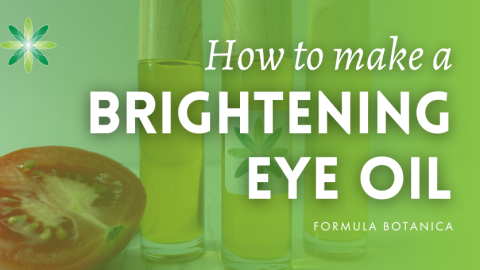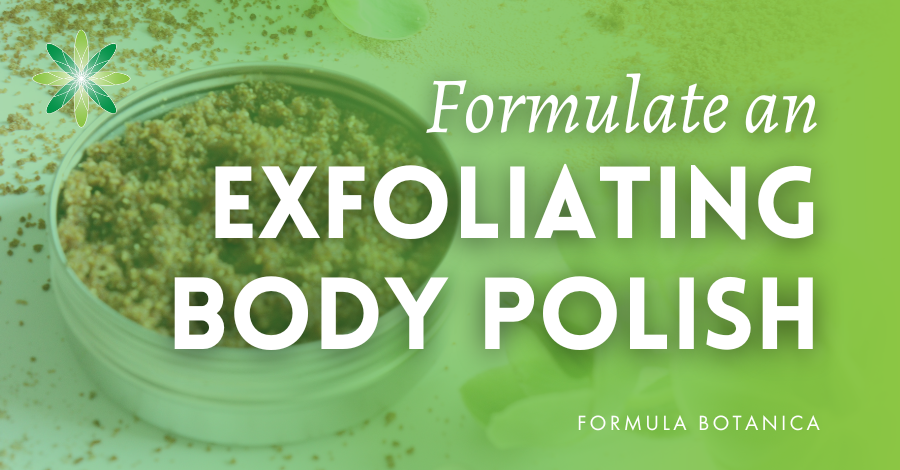In this latest blog post we introduce Xyliance, an Ecocert-certified and vegan oil-in-water emulsifier. Formula Botanica’s team is publishing a series on working with different natural emulsifiers. So far we have covered:
- How to make an emulsion with Vegetal (Cetearyl Alcohol (and) Cetearyl Glucoside)
- How to make an emulsion with Olivem 900 (Sorbitan Olivate)
What is an emulsion?
An emulsion is a blend of water and oil, which are brought together by the use of an emulsifier – creating a homogenous blend. There are many emulsifiers on the market that may be used by natural skincare formulators. They can be oil-in-water or water-in-oil emulsifiers, or they can be hot processed or cold processed (want to learn more about the science of emulsification? Check out our Advanced Diploma in Organic Cosmetic Science).
Your choice of emulsifier is a personal preference but you need to consider many other factors. Please read our previous article to help you make a decision on which emulsifier is suitable for you and your product needs.
Introducing Xyliance
Xyliance® is one of the oldest natural emulsifiers on the market, if we exclude lecithin. It is solid at room temperature and its application temperature is around 70 oC. It has a pale beige to white colour with no impact on the colour of the emulsion. In fact, Xyliance creates emulsions with a white and luxurious appearance, unless you blend it together with oils, butters and extracts that have a significant colour. Xyliance was originally a palm oil-free emulsifier but since Soliance was taken over by Givaudan, this emulsifier is no longer palm oil-free (from 2015).
Its INCI name is:
Cetearyl wheat straw glycosides and Cetearyl alcohol
How to use Xyliance in your emulsions
- Solubility: in oil – add to your oil-phase
- Oil-phase concentration: works with oil phases between 20-45%
- Process: hot process
- Dosage: 3.5 – 8%
Xyliance is a hot process emulsifier, which means that both the water and oil phase must be heated to at least 70 oC. If you’re working with butters and waxes with a higher melting point, then obviously you should increase the heating temperature. It is a very forgiving and easy to apply emulsifier, suitable for high oil concentrations (20-45%). It creates medium to high viscosity emulsions and creams. It doesn’t work well at low oil concentrations and is not suitable to create low viscosity emulsions or sprayable milks.
Like many other oil-in-water emulsions, this emulsifier has a low electrolyte (salt) tolerance and the emulsions made with Xyliance break upon addition of salts.
I like the emulsions made with this emulsifier for their silky, non-greasy and non-soapy skin feel and for their fluffy texture. It is one of the emulsifiers which I would certainly use when working with waxes and butters, where you need to heat the oil phase. Xyliance works even without applying a gum but the long-term stability is much better when you apply a viscosity modifier (a gum) and an emulsion stabiliser.
Learn how to make emulsions with Xyliance #CosmeticScience #NaturalSkincare Share on XBlending Xyliance in your emulsions
You can add the oil phase to the water phase or vice versa. According to our experience, Xyliance performs better when the water phase is slowly added to the oil phase. You can add the gum at the beginning to the water phase (if you have an efficient gum dispersing tool) or disperse the gum in glycerine or a glycol and add this phase after the emulsification. You can vary the texture and viscosity of the emulsion by varying the oil phase concentration and the emulsifier: oil ratio.
With low batch volumes you can create stable emulsions without a homogenizer however, Xyliance is an emulsifier that likes high shear. For that reason we recommend the use of a Kai Blendia or a professional rotor/stator homogenizer which improves the stability and texture of the emulsions.
Xyliance not only works perfectly with plant oils and butters, it can emulsify ester oils, hydrocarbons and even silicone oils (which we don’t use in natural cosmetics). It is an excellent emulsifier for hand and body creams, rich facial creams and mask and hair care products such as deep conditioners and masks with high oil concentrations.
Our example emulsions with Xyliance
We’re going to show you some examples of emulsions made with Xyliance. We’re then going to change the oil phase concentration, and apply a butter or ester oils etc to vary the texture of the emulsion.
In testing out Xyliance, we made a simple formulation and observed its accelerated and long term stability over a period of 6-18 months. We’re going to share these results with you here.
Variation 1: Modifying the oil phase concentration and emulsifier:oil ratio
| Phase A | |
| Organic poppy seed oil | Variable between 15-45% |
| Xyliance | Variable between 3.5-6.5% |
| Tocopherol | 0.5% |
| Phase B | |
| Freshly boiled distilled water | To 100.0% |
| Panthenol | 0.5% |
| Dermofeel PA-3 | 0.1% |
| Phase C | |
| Solagum AX | 0.5% |
| Organic glycerine (99%) | 4.0% |
| Phase D | |
| NaOH 25% solution | To adjust the pH |
| Euxyl K903 | 1.0% |
Formulation Method:
- Heat phase A and B separately in a water bath at 70-75o Celcius. Then blend each phase separately to a homogeneous mixture.
- When the emulsifier has melted, stop heating the mixture and slowly add the water phase to the oil phase while stirring the oil phase.
- Blend the gum and glycerine and add this blend to the emulsion. Homogenise the emulsion with your Kai blendia or any other suitable homogenizer.
- Stir further and start cooling.
- As the blend reaches approx. 35 oC add 2-3 drops of a Sodium hydroxide solution to the emulsion to raise the pH and then add the preservative (Euxyl K903). Since we know that this preservative reduces the pH, we first increase the pH and then add the preservative. If you are using another preservative, you may need to first add the preservative and then adjust the pH.
- Prepare a 10% dilution of the emulsion and measure the pH. It should be between 5.0 – 5.5. If it is higher, you can reduce it by adding an acid and if it is lower, you can increase it by adding a base.
- Take stability samples to observe the stability of the product under different conditions, take your microkit sample and fill the rest (if anything remains) in a suitable jar.
Results of our Experiment with Xyliance:
Like any other oil-in-water emulsion, the viscosity of the emulsion increases by increasing the oil phase concentration and the emulsifier-to-oil ratio.
In this photo you can see a series of emulsions with 35.0% of poppy seed oil and varying emulsifier concentrations between 4.5-6.0%. By keeping the oil concentration constant and increasing the emulsifier concentration, the viscosity increases and the texture changes to a rich and thick cream. As you can tell from the photo, 4.5% xyliance is too low for a 35.0% oil phase and this emulsion therefore did not pass our thermal stability test.
In this photo, you can see another example of varying texture in the emulsion by changing the oil concentration from 15.0% to 25.0%. We measured the viscosity with our lab viscometer and the graphic shows the different in viscosity in milliPascal seconds (mPas). By keeping the oil phase concentration and the oil-to-emulsifier ratio constant, we can create various viscosities and textures in our emulsions by changing the oil.
In this photo we’ve used the following combinations from left to right:
- 25% organic poppy seed oil, 10.0% isoamyl laurate (an ester oil), 5.5% Xyliance
- 25% organic poppy seed oil, 10.0% organic babassu oil, 5.5% Xyliance
- 25% organic poppy seed oil, 10.0% Lexfeel natural (a natural silicone alternative), 5.5% Xyliance
- 25% organic poppy seed oil, 10.0% shea butter, 5.5% Xyliance
The yellow bars in the image indicate the viscosity of the emulsion, as measured by our lab’s viscometer in milliPascal seconds.
As you can easily see from the emulsions and the viscosity diagrams, by applying shea butter and babassu oil the viscosity increases and by applying the ester oil or Lexfeel natural the viscosity decreases. This provides you with an opportunity to create a broad range of products from medium viscosity cleansing milks to rich hand and feet creams or emulsion masks by just playing with the oil phase concentration or swapping one of the oil phase components.
Bonus Sample Formulation with Xyliance
Soothing Turmeric Emulsion Mask
Try making our sample formulation for this wonderful emulsion mask. We’ve included some exotic oils and waxes which are great fun to use in your formulations.
| Phase A | |
| Xyliance | 6.0% |
| Wild crafted Pequi fruit oil | 5.0% |
| Organic myrica fruit wax | 2.0% |
| Organic baobab seed oil | 10.0% |
| Organic poppy seed oil | 15.0% |
| Curcuma infused organic jojoba oil | 2.5% |
| Tocopherol | 0.5% |
| Phase B | |
| Freshly boiled distilled water | 38.7% |
| Sodium lactate | 2.0% |
| Panthenol | 1.0% |
| Dermofeel PA-3 | 0.1% |
| Phase C | |
| Vegeluron | 5.0% |
| Hydroglyceric extract of alfalfa and fenugreek sprouts | 2.5% |
| Hydroglyceric jiaogulan extract | 2.0% |
| Hydroglyceric artichoke leaf extract | 2.0% |
| Phase D | |
| Solagum AX | 0.4% |
| Organic glycerine (99%) | 4.0% |
| Phase E | |
| Euxyl K903 | 0.8% |
| Organic amyris EO | 0.3% |
| Organic ylang-ylang EO | 0.2% |
| NaOH solution (25%) | 3-4 drops to adjust the pH |
Method of Manufacture
- Heat phase A and B separately in a water bath @ ca. 68-70 oC. Do not heat and hold your ingredients (not sure why? read this article).
- When xyliance and myrica wax are melted blend each phase separately and slowly add phase B to phase A while stirring phase A.
- Homogenize the emulsion.
- Blend phase C in another beaker at room temperature and add this to the emulsion.
- Blend glycerine and gum in another beaker and add this to the emulsion. You may want to use your blender or homogeniser (such as the Kai Blendia) for a few bursts to fully disperse the gum.
- Stir as the emulsion cools down.
- As the temperature reaches around 40 oC add 3-4 drops of the NaOH and then add the preservative. We do this because we know by experience that this preservative (Euxyl K903) reduces the pH. If you’re using another preservative you many need to first measure the pH of the emulsion before adding the preservative or adjusting it.
- Add the preservative and essential oils.
- Prepare a 10% dilution of the emulsion and measure the pH either by an electrode or a pH strip. The pH should be between 5.0-5.0 for this preservative. If it is lower than 5.0 add NaOH to increase it and if it is higher than 5.5 add a lactic or citric acid solution to decrease the pH to the required range.
- Take your stability and microkit samples and fill the rest in a suitable jar. Do not completely close the lid if the emsulion is not yet fully cold (the condensed water might cause instability if you close the lid when the emulsion is till warm).
Now it’s your turn! Purchase a sample of Xyliance and show us the emulsions you made by hashtagging it with #FormulaBotanica on Instagram. If you are new to formulating and want to learn how to emulsify, then enrol today for our Diploma in Organic Skincare Formulation.
Have you ever used Xyliance? What are your formulating experiences? Share with us in the comments below.
FREE TRAINING
Learn how to become an
Organic Skincare Formulator
FREE TRAINING
How to become an
Organic Skincare Entrepreneur
FREE TRAINING
How to become an
Organic Skincare Entrepreneur
Leave us a comment

Dr. Elham Eghbali was Formula Botanica’s Cosmetic Chemist between 2014 and 2018. She has over 20 years’ industry experience and is based in Bavaria, Germany. To read more about Formula Botanica’s team, visit our staff page.


